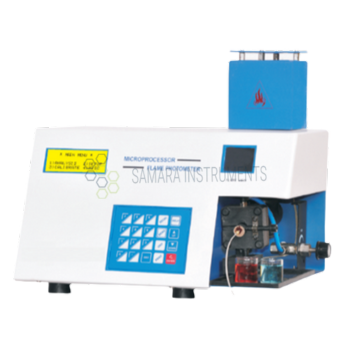
Flame Photometer
A Flame Photometer is a scientific instrument used for the quantitative analysis of certain elements Read more
Understand Flame Photometer
A Flame Photometer is a scientific instrument used for the quantitative analysis of certain elements based on their emission of light when vaporized in a flame. It is commonly used in analytical chemistry and is particularly useful for measuring the concentration of alkali and alkaline earth metals in a sample.
The principle behind a flame photometer is the measurement of the intensity of light emitted by atoms in a flame when they are excited by heat. When a solution containing the element of interest is introduced into a flame, the heat vaporizes the solvent and breaks down the chemical compounds, releasing individual atoms into an excited state. As these atoms return to their ground state, they emit characteristic wavelengths of light, which can be detected and measured.
The basic components of a flame photometer include a flame, a nebulizer or spray chamber to introduce the sample into the flame, a monochromator or filter to select the desired wavelength of light, a photodetector to measure the intensity of light, and a readout or display to show the results.
To perform an analysis using a flame photometer, a calibration curve is typically established using standard solutions of known concentrations. The unknown sample is then prepared and introduced into the flame, and the instrument measures the intensity of light emitted at the specific wavelength corresponding to the element of interest. By comparing the measured intensity with the calibration curve, the concentration of the element in the sample can be determined.
Flame photometry has found wide application in various fields, including environmental analysis, clinical chemistry, pharmaceuticals, and research laboratories. It is particularly well-suited for measuring elements such as sodium, potassium, calcium, and lithium, which have characteristic emission wavelengths in the visible range of the electromagnetic spectrum.
In recent years, advancements in analytical instrumentation have led to the development of more sophisticated techniques, such as atomic absorption spectrometry and inductively coupled plasma spectroscopy, which offer greater sensitivity and the ability to analyze a wider range of elements. However, flame photometers remain valuable tools for routine elemental analysis, thanks to their simplicity, reliability, and cost-effectiveness.
| Model No | SI - MFPM/1382 | ||
|---|---|---|---|
| General Range ppm meq/I | Serum Range meq/I | Urine Range | |
| Range | Na : 0-100 Upto 250 meq/I, 1:100 dil. K : 0-100 Upto 250 meq/I, 1:100 dil. Ca : 0-100 Upto 250 meq/I, 1:100 dil. Li : 0-100 Upto 250 meq/I, 1:100 dil. Ba : 50-1000 | 0-200 meq/I, 1:100 dil. 0-10 meq/I, 1:100 dil. 0-2 meq/I, 1:5 dil. | 0-250 meq/I, 1:100 dil. 0-100 meq/I, 1:100 dil. 0-10 meq/I, 1:2 dil. |
| Sensitivity | General Mode : Na:0.5 ppm, K:0.5 ppm, Li:0.5 ppm, Ca:15 ppm, Ba : 50 ppm | ||
| Filters | Na & K Supplied (Ca & Li are optional at extra cost) | ||
| Resolution | 0.1 ppm / 0.1 meq. | ||
| Reproducibility | < 1% coefficient of variation for 20 consecutive samples using 10 ppm Na set as Maximum Standard | ||
| Linearity | < 2% error when 3 ppm Na/K and 5 ppm Li are set as Maximum Standard | ||
| Curve Fit Accuracy | ±2% of FS | ||
| Display | 20 x 4 Character alphanumeric LCD display with backlit | ||
| Average Time | In-built in Software | ||
| Flame System | LPG & Dry Oil Free Air | ||
| Detector | Photodiode | ||
| Calibration | Up to 5 Point Calibration with Curve Fitting Software | ||
| Gas Control | Adjustable with knob | ||
| Ignition System | Auto Ignition | ||
| Automiser | Axial Flow Type | ||
| Dimensions(LxBxH) | Instrument : 285 x 255 x 210 mm Approx. Box : 600 x 360 x 320mm | ||
| Printer | Provision for attachment of Dot-Matrix Printer or HP Laserjet/ Inkjet printer(non-win printers) with centronics parallel interface | ||
| RS 232 Interface | Available (PC software at extra cost) | ||
| Weight | Main Unit : 9 Kg. (Approx.) Box: 10.5 Kg (Approx) | ||
| Power Supply | 230 V AC ± 10%, 50 Hz | ||
| COMPRESSOR UNIT | |||
| Air Supply | By oil free mini compressor unit with pressure regulator | ||
| Combustion Gas LPG | Controlled by precision regulator | ||
| Power | 230 V ± 10% AC, 50 Hz | ||
| Dimensions(LxBxH) | 290 x 255 x 210 mm (Approx.) ; Box 370 x 358 x 300mm | ||
| Weight | 8 Kg. (Approx.) Box: 9 Kg (Approx.) | ||
- μP Based With Printer Interface
- Five Element Measurement In Single Aspiration
- Calibration Curve Programmability Using
- Maximum of 5 Standards
- Data Processing Through Curve Fitting
- Techniques – Least Squares, Quadratic
- Multiple Calibration Curves Saving Facility
- Samples Data Storage Facility
- Online Help Key
- Printer Attachment Facility
- Measurement In ppm & meq
- Useful For Both Medical & Soil Testing
- Setup Storage Facility upto 10 setups
- Selective Element Analysis
- Wide Concentration Range
- Simplicity and Ease of Use
- Rapid Analysis
- Robustness and Durability
- Portable Options
- Multiple Element Analysis
Applications of Flame Photometer:-
MICROPROCESSOR FLAME PHOTOMETER, MODEL 1385 Comes with Flame Failure Detection and Auto Gas Cutoff Facility. In case of power failure, the gas cuts off automatically. In case the flame goes off accidentally during work, the flame failure alarm sounds after a few seconds
Both Microprocessor Flamephotometers Model 1382 are used for the determination of Sodium, Potassium, Calcium, Lithium & Barium. They use the latest microcontroller technology and advanced engineering techniques to give enhanced accuracy and reproducibility. They have soft touch membrane keys for ease of operation. The solution is aspirated through an atomizer. Air, sample and fuel are mixed in the mixing chamber which is then sprayed as a very fine mist into the flame. Radiations from the flame pass through a specific narrow-band interference filter and pass to the photodetector. The final results are displayed on the 20 x 4 alphanumeric LCD. The standard model comes with 2 filters (Na & K). Additional filters Ca & Li are optional at extra cost.
In both models, 5 point calibration facility and non-linearity correction are provided through automatic curve fitting software. The facility has been provided for re-standardization with a single standard, thereby, eliminating the need for multiple standards once a calibration has been performed.
To purchase this product you connect with us over whatsapp
- μP Based With Printer Interface
- Five Element Measurement In Single Aspiration
- Calibration Curve Programmability Using
- Maximum of 5 Standards
- Data Processing Through Curve Fitting
- Techniques – Least Squares, Quadratic
- Multiple Calibration Curves Saving Facility
- Samples Data Storage Facility
- Online Help Key
- Printer Attachment Facility
- Measurement In ppm & meq
- Useful For Both Medical & Soil Testing
- Setup Storage Facility upto 10 setups
- Selective Element Analysis
- Wide Concentration Range
- Simplicity and Ease of Use
- Rapid Analysis
- Robustness and Durability
- Portable Options
- Multiple Element Analysis
Applications of Flame Photometer:-
MICROPROCESSOR FLAME PHOTOMETER, MODEL 1385 Comes with Flame Failure Detection and Auto Gas Cutoff Facility. In case of power failure, the gas cuts off automatically. In case the flame goes off accidentally during work, the flame failure alarm sounds after a few seconds
Both Microprocessor Flamephotometers Model 1382 are used for the determination of Sodium, Potassium, Calcium, Lithium & Barium. They use the latest microcontroller technology and advanced engineering techniques to give enhanced accuracy and reproducibility. They have soft touch membrane keys for ease of operation. The solution is aspirated through an atomizer. Air, sample and fuel are mixed in the mixing chamber which is then sprayed as a very fine mist into the flame. Radiations from the flame pass through a specific narrow-band interference filter and pass to the photodetector. The final results are displayed on the 20 x 4 alphanumeric LCD. The standard model comes with 2 filters (Na & K). Additional filters Ca & Li are optional at extra cost.
In both models, 5 point calibration facility and non-linearity correction are provided through automatic curve fitting software. The facility has been provided for re-standardization with a single standard, thereby, eliminating the need for multiple standards once a calibration has been performed.
To purchase this product you connect with us over whatsapp
You May Also Like















